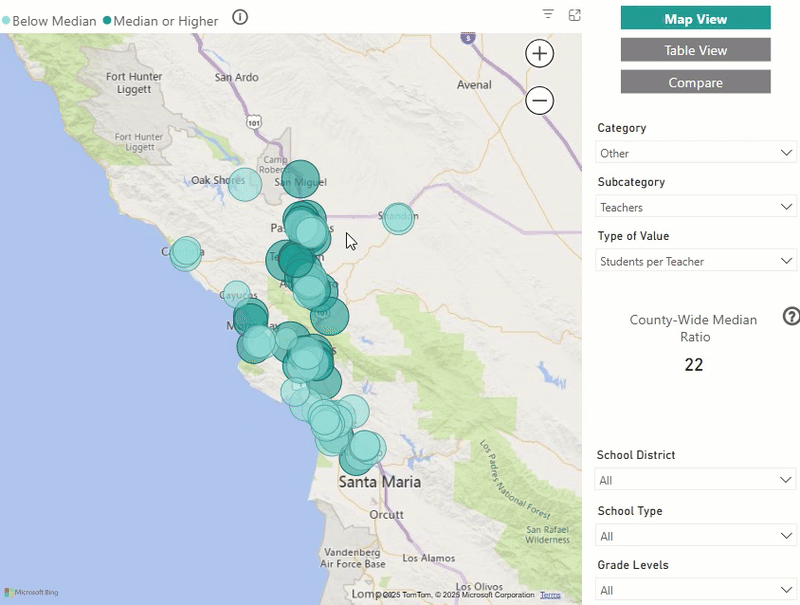Emitir resúmenes
De vez en cuando destacamos otras áreas que impactan en la salud. Vea una lista de nuestros últimos resúmenes de problemas a continuación.
¡Consejo! Seleccione elementos en la leyenda para activarlos o desactivarlos.

Technical Details and Data Definitions
Data Suppression
To protect student privacy, categories with five or fewer students are censored. For example, if there were three students at Paso Robles High who were eligible for free or reduced-price meals, then the count and percent values would be set to a null value and would not appear in the map or table views.
Abbreviations
GED: General Educational Development, a high school equivalency certificate
CCC: California Community College
CSU: California State University
UC: University of California
IEP: Individualized Education Programs
Graduation
-
High School Completers: Students who graduated from a public high school with a regular diploma or finished high school as a non-graduate completer. Non-graduate completers include those who finished high school with a GED or adult education diploma but does not include those who got a Special Education Certificate of Completion.
-
GED or Alternative Certificate: Students who did not receive a regular high school diploma and instead got an equivalent certificate such as a GED, adult education high school diploma, Special Education Certificate of Completion, or California High School Proficiency Exam (CHSPE).
-
Dropout: Students who did not graduate with a regular high school diploma, did not complete high school, and are not still enrolled as a "fifth year senior".
-
Met A-G Requirements for UC or CSU: Students who met the A-G requirements to admission to a UC or CSU school.
Language
-
English Learner: Students who are reported to speak a language other than English and who are assessed to not have the English language skills necessary to succeed in the school’s regular instructional programs.
Post-Secondary Enrollment
-
Enrolled: Public high school completers who enrolled in any postsecondary institution within 12 months of completing high school. This includes those who are enrolled in 2-year and 4-year institutions, public and private institutions, and in-state and out-of-state institutions.
-
Not Enrolled: High school completers who did not enroll within 12 months of completing high school or whose records were blocked from being shared.
Socioeconomic Factors
-
Socioeconomically Disadvantaged: Students who meet at least one of the following criteria: neither parent received a high school diploma, are eligible for the Free or Reduced-Price Meal Program, are eligible for the Title I Part C Migrant Program, are considered homeless, are Foster Program Eligible, are Directly Certified, are enrolled in Juvenile Court Schools, or are eligible as a Tribal Foster Youth.
-
Free or Reduced Meal Eligible: Students who are eligible for free or reduced-price meals due to having a special status (such as homeless, migrant, or foster youth) or if their family’s income is below a specified threshold.
-
Homeless: Students who lack a fixed, regular, and adequate nighttime residence, such as students who are living in motels, cars, or sharing housing with others due to loss of housing.
-
Migrant: Students who have a parent or guardian who is a migratory worker and whose family has moved in the past three years.
-
Foster: Students who are identified as being in foster care.
Special Education
-
Students with Disabilities: Students who qualifies for and needs special education or related services, such as students with an active IEP.
-
Regular Class at Least 80% of the Day: Students who participate in a regular general education classroom setting at least 80 percent of the school day.
-
Regular Class Less Than 80% of the Day: Students who participate in a regular general education classroom setting less than 80 percent of the school day.
-
Placed in Other Setting: Students: Students place in program settings where they receive services in a separate school, residential facility, private school, at-home, or at a service provider’s location.
Other
-
Total Enrollment: Number of students enrolled at the school.
-
Teachers: Full-time equivalent sum of the number of teachers assigned to teaching duties.
School Type
-
Alternative Schools of Choice: A voluntary school that offers students different ways of meeting grade-level standards. Typically have different instructional styles and smaller class sizes.
-
Continuation: Serves students who are at least 16 years of age and are at risk of not graduating from high school.
-
County Community: Serves students who are expelled from school or are referred to the school due to attendance or behavior problems. It also serves students who are homeless, on parole or probation, or who are not attending school.
-
Juvenile Court: Serves students who are under the protection or authority of the juvenile court system and are in an incarcerated setting.
-
Special Education: Serves students with disabilities.
-
Traditional: Elementary, Middle, or High School
